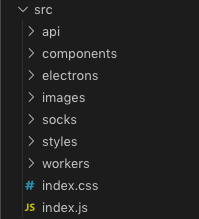Securing Electron app source code
28 Oct 2019
Electron is one of the best ways for building cross-platform desktop apps. When I was evaluating a toolkit for building Viwr, Electron was a clear winner over nw.js and Qt-based on the community, resources and available libraries.
📚 My Electron stack
- Electron : 5.0.4
- ReactJS : 16.4.1
In this codebase, obfuscation and mangling for ReactJS are done by the react-scripts. This blog mainly focuses on obfuscating electron related codebase.
🏗 Code structure
I am using ReactJS for writing the front-end part of the Electron app. I have not used any scaffolding scripts for this.

src
src is the entry point for all the source code. This folder contains index.js and index.css which are ReactJS specific.
electrons
This folder contains all the BrowserWindow`s and corresponding main thread related code. We will be obfuscating files in this folder.components
This folder contains all theReactJS components.
🛡 Securing the source code
Securing the source code is one of the most important steps before releasing any app (unless it’s an open-source project). There is very little help available on the web regarding obfuscating and mangling the electron source code.

Icons by Nermin from glazestock.com
📦 Tools
1. CRACO
This is required only if you are using ReactJS for writing your Electron app.
Create React App Configuration Override (CRACO) is an easy and comprehensible configuration layer for create-react-app.
Get all the benefits of create-react-app and customization without using ‘eject’ by adding a single craco.config.js file at the root of your application and customize your eslint, babel, postcss configurations and many more.
craco.config.jsmodule.exports = {
webpack: {
configure: (webpackConfig, { env, paths }) => {
// Adding rule for web workers
webpackConfig.module.rules.push({
test: /\.worker\.(js|jsx|mjs)$/,
use: {
loader: "worker-loader",
options: {
fallback: false,
inline: true
}
}
});
webpackConfig.target = "electron-renderer";
webpackConfig["output"]["globalObject"] = "this";
webpackConfig["optimization"]["noEmitOnErrors"] = false;
webpackConfig["node"]["fs"] = "empty";
return webpackConfig;
}
}
};
This script
- Adds a worker-loader for the renderer thread flow.
- Sets up the target as electron-renderer.
- Enables
fsin renderer-thread land.
2. Webpack
An all in one tool for bundling any javascript project. I used a webpack script for merging all my electron main thread codebase into one single object.
webpack.config.jsconst path = require("path");
const fs = require("fs");
let node_modules = {};
fs.readdirSync("node_modules")
.filter(function(x) {
return [".bin"].indexOf(x) === -1;
})
.forEach(function(mod) {
node_modules[mod] = "commonjs " + mod;
});
module.exports = {
mode: "production",
entry: "./src/electrons/main.js",
output: {
pathinfo: true,
path: path.resolve(**dirname, "build"),
filename: "electrons.raw.js",
globalObject: "this"
},
externals: node_modules,
node: {
**filename: false,
\_\_dirname: false
},
stats: "errors-only",
target: "node"
};
This script
- Combines all the electron main thread code (all the BrowserWindows), and merge them into one single file called
electrons.raw.js. - The obfuscation part for renderer thread is handled by
react-scripts.
3. Terser
A JavaScript parser and mangler/compressor toolkit for ES6+.
terser --compress --drop_console=true --mangle -- build/electrons.raw.js > build/electrons.js
This command
- Obfuscated and mangles the single merged file we have created using webpack. The final output looks something like
!function(e){var t={};function n(r){if(t[r])return t[r].exports;var i=t[r]={i:r,l:!1,exports:{}};return e[r].call(i.exports,i,i.exports,n),i.l=!0,i.exports}n.m=e,n.c=t,n.d=function(e,t,r){n.o(e,t)||Object.defineProperty(e,t,{enumerable:!0,get:r})},n.r=function(e){"undefined"!=typeof Symbol&&Symbol.toStringTag&&Object.defineProperty(e,Symbol.toStringTag,{value:"Module"}),Object.defineProperty(e,"__esModule",{value:!0})},n.t=function(e,t){if(1&t&&(e=n(e)),8&t)return e;if(4&t&&"object"==typeof e&&e&&e.__esModule)return e;var r=Object.create(null);if(n.r(r),Object.defineProperty(r,"default",{enumerable:!0,value:e}),2&t&&"string"!=typeof e)for(var i in e)n.d(r,i,function(t){return e[t]}.bind(null,i));return r},n.n=function(e){var t=e&&e.__esModule?function(){return e.default}:function(){return e};return n.d(t,"a",t),t},n.o=function(e,t){return Object.prototype.hasOwnProperty.call(e,t)},n.p="",n(n.s=63)}([function(e,t){e.exports=require("tslib")},function(e,t){e.exports=require("electron")},function(e,t,n){"use strict";Object.defineProperty(t,"__esModule",{value:!0});var r=n(34);t.addBreadcrumb=r.addBreadcrumb,t.captureException=r.captureException,t.captureEvent=r.captureEvent,
Script for building the codebase
RED='\033[0;31m'
GREEN='\033[0;32m'
NC='\033[0m'
rm -r dist || true && rm -r build || true
# To build reactjs
yarn build
if [[ $? -ne 0 ]]; then
echo "${RED}BUILD FAILED${NC} => $?"
exit -1
fi
# To bundle the code
yarn bundle
if [[ $? -ne 0 ]]; then
echo "${RED}BUNDLING FAILED${NC} => $?"
exit -1
fi
# Obfuscating the code
terser --compress --drop_console=true --mangle -- build/electrons.raw.js > build/electrons.js
if [[ $? -ne 0 ]]; then
echo "${RED}OBFUSCATION FAILED${NC} => $?"
exit -1
fi
# Final packaging electron-builder
electron-builder --config.extraMetadata.main=build/electrons.js
resp=$?
echo $resp
if [[ $resp -ne 0 ]]; then
echo "${RED}PACKING FAILED${NC} => $resp"
exit -1
fi
🙇♂️ Thanks